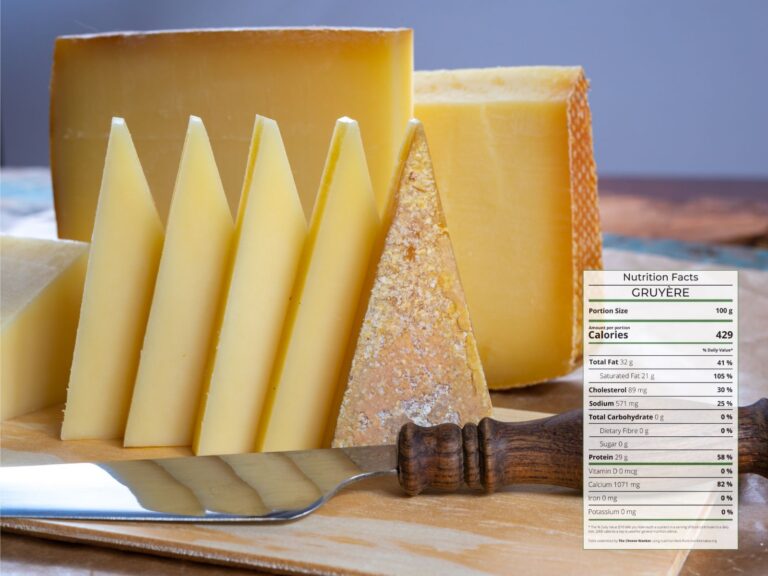Without a doubt, Switzerland’s most famous exports are cheese, chocolate and watches (in this order!). And Swiss cheeses do not get much more famous and spectacular than Gruyère. Read on to learn all about this stunning pressed cooked cheese. In this post, we will cover the history and production of Gruyère. As well as tasting notes and how best to cook with it.
SEE ALSO: Nine stunning Swiss cheeses that are guaranteed to knock your socks off →
What is Gruyère?
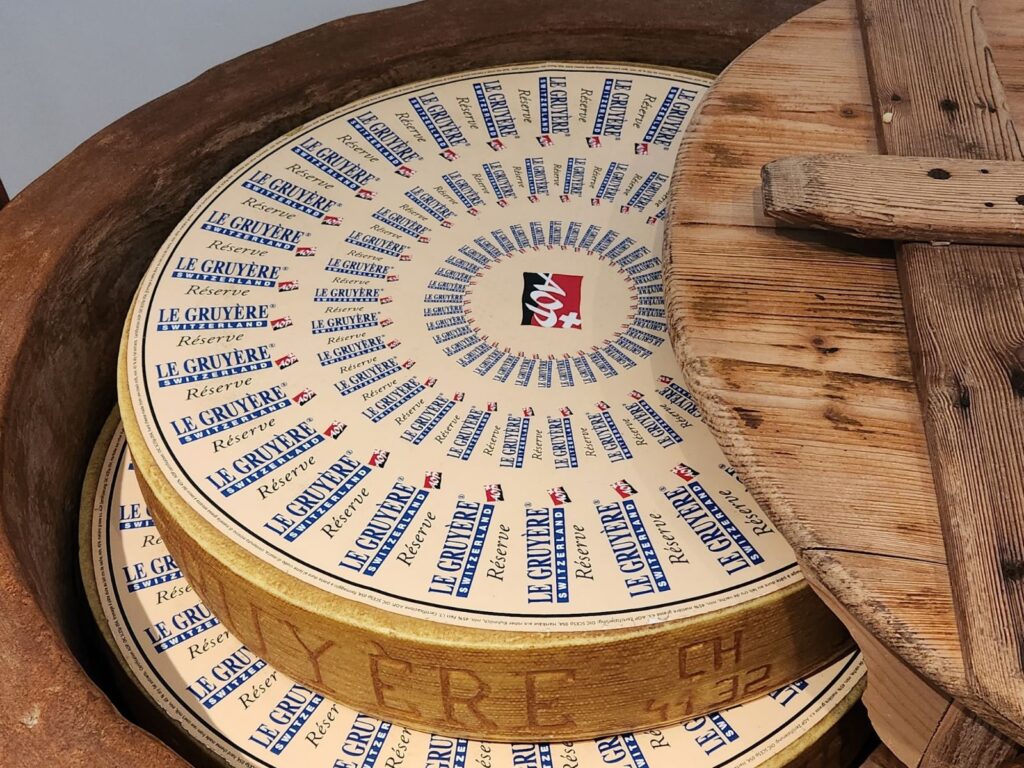
Gruyère is a pressed cooked cheese that originated in the canton of Fribourg, Switzerland. It is named after the medieval village of Gruyères, where it has been produced for centuries. As a matter of fact, the history of this traditional cheese can be traced back to the 12th century, when the Monks of Gruyères began making it in the region.
During the Middle Ages, the cheese was traded in local markets and became a staple food for the people of the region. In the 19th century, Gruyère cheese production increased significantly due to the development of new transportation methods and the expansion of the cheese’s popularity beyond Switzerland.
Today, Gruyère bears an AOP stamp of protection, meaning that it can only be produced in a specific region of Switzerland using traditional methods. It is also widely exported and enjoyed around the world.
How to pronounce Gruyère
If you’ve ever wondered how to properly pronounce the name of this French Swiss cheese, our video below till sort you out!
Where is Gruyère made?
Presently, the AOP restricts the production of Gruyère to the Cantons of Fribourg, Vaud, Neuchâtel, Jura and Bern. Indeed, Fribourg is home to the tiny village of Gruyères, where cheese has been made for more than 800 years. As a matter of fact, Gruyères is home to La Maison du Gruyère, a museum/cheesemaking facility that is open to the public.
In addition to the geographic requirements, the AOP stipulates that local cheesemakers have to exclusively use the raw milk of local grass-fed cows. The farmers are not allowed to feed their cattle silage and have to deliver fresh milk twice a day to the licenced cheesemaking facilities.
Traditional production methods
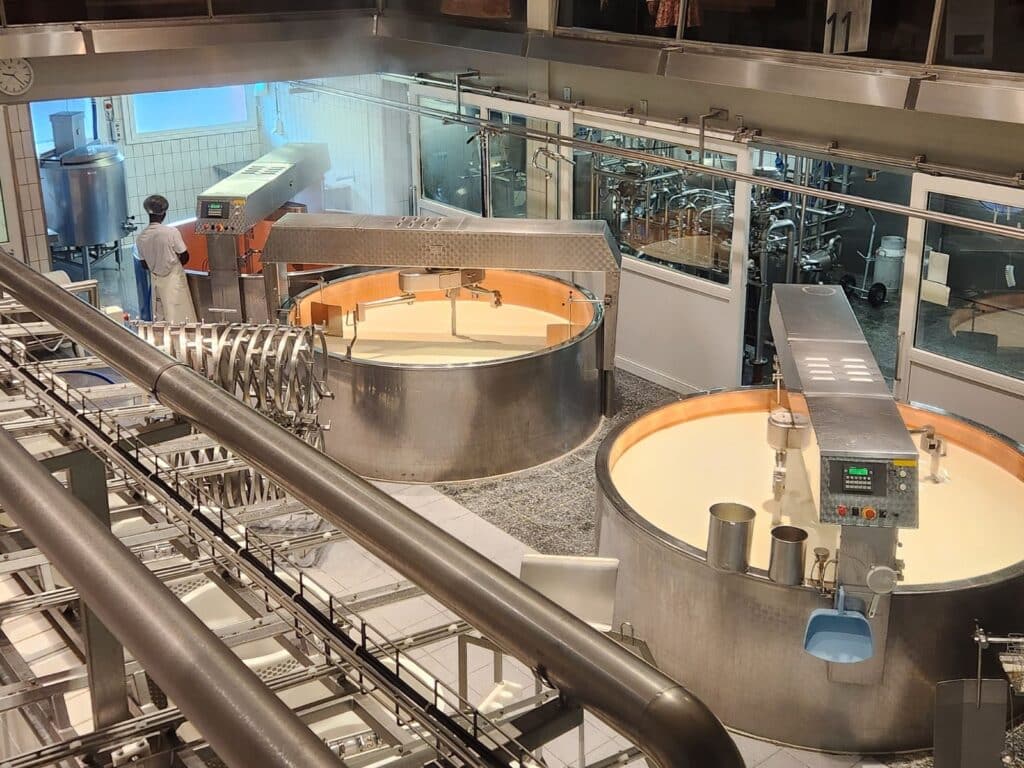
Unsurprisingly, the AOP also dictates the traditional methods for Gruyère production. The production process begins with heating the milk to a temperature of around 32-35°C (90-95°F) and adding rennet, which causes the milk to coagulate and form curds. The cheesemaker then cuts the curds, heats them and drains the whey.
The curd is then shaped and placed into moulds to give the cheese its characteristic round shape. Actually, each mould carries a marking on its outer edge saying Le Gruyère AOP and stating the producer’s unique identifier number. Finally, the maker places a casein marking onto the curd mass indicating the number of the cheese wheel, the date and the producer.
Afterwards, they press each wheel of cheese for about 20 hours with an applied force of up to 900 kg. As a result, excess whey drains leaving a solid mass behind which becomes the cheese. On day two, the cheesemaker removes the formed cheese from its mould and places it in a concentrated salt bath for a further 24 hours. They are now ready for maturation.
The slow maturation of Gruyère
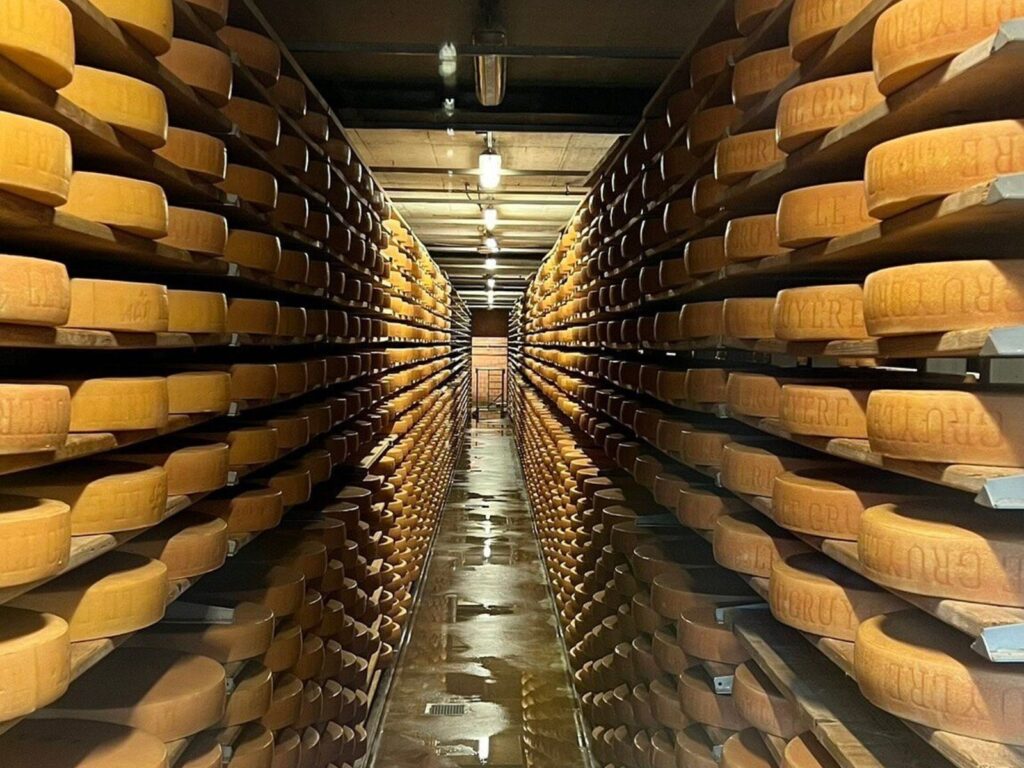
As a matter of fact, the first three months of ageing take place in the cheesemaker’s cellar. During this time, they regularly turn each wheel of cheese and brush them. Overall, this process allows the formation of an even texture throughout the cheese’s paste and a gorgeous brown rind around the cheese.
After three months, the wheels leave the cheese dairy to move into maturing cellars. Once again, the AOP regulates the conditions in those cellars to allow for optimum maturation of Switzerland’s most treasured cheese. Indeed, regardless of the facility, humidity has to be maintained at 90% and the temperature at 15°C (or 59°F).
This stage of affinage can last between 5 and 18 months. During this time, an affineur (or robot) turns each wheel regularly. And a human affineur brushes each individual wheel of cheese with a proprietary salt water mixture.
The different types of Gruyère
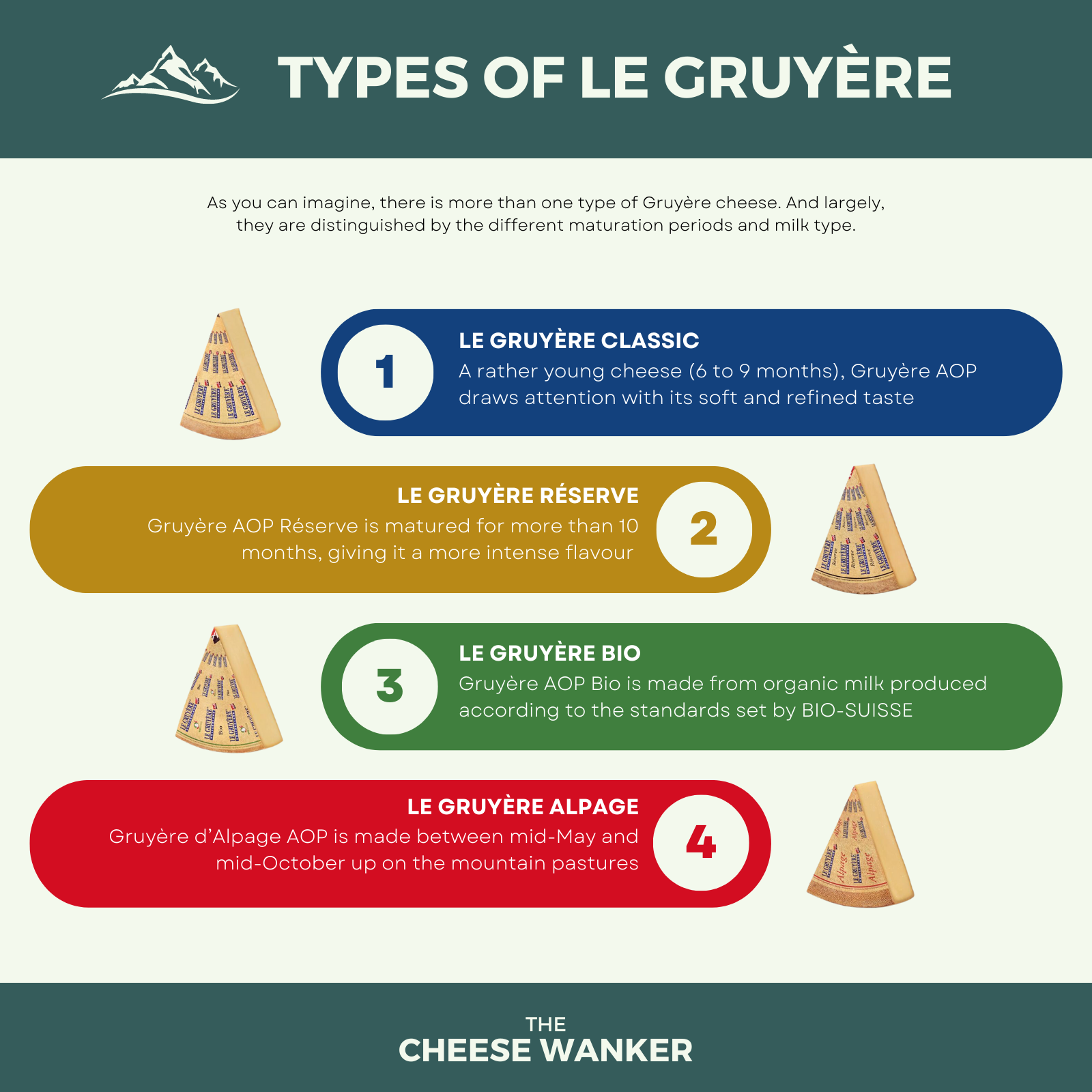
As you can imagine, there is more than one type of Gruyère cheese. And largely, they are distinguished by the different maturation periods. A young Gruyère between 6 to 9 months is called Classic. On the other hand, wheels that have matured for more than 10 months are branded Réserve.
In addition to aged variants of Gruyère, you can find an organic version called Bio and, most importantly, a summer milk version called Alpage. Gruyère d’Alpage is exclusively made between mid-May and mid-October in mountain pastures.
Due to the great variety of pasture lands and the spectacular alpine flora, the cows produce their finest milk during those months.
And, as always, high quality milk makes high quality cheese. Once they have collected the milk, the farmers add rennet for coagulation. Afterwards, they press the curd mass in cloth and form wheels that are slightly smaller than the other types of Gruyère. Indeed, a regular Gruyère will weigh up to 40 kg (88 lbs) whereas Alpage wheels are typically 25 kg (55 lbs).
What does Gruyère taste like?
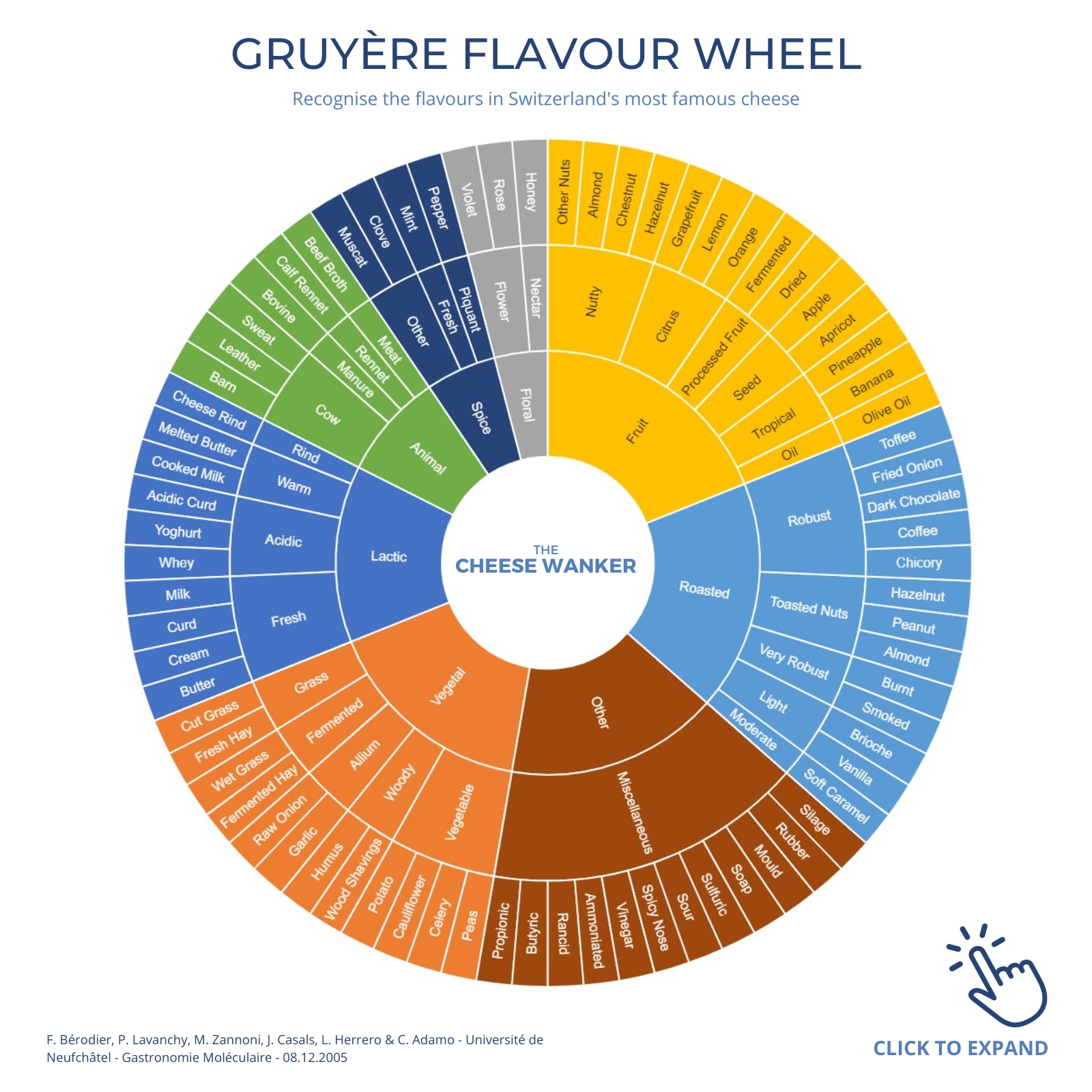
Unsurprisingly, the flavour of Gruyère varies depending on its age and the season. A Classic will exhibit mostly fresh sweet notes including apple, pineapple, cream, wet grass, honey and almond.
But, as the cheese ages, its flavour becomes more and more complex. Indeed, a 12-month-old wheel will display an incredible array of flavours. Watch out for notes of hazelnut, dark chocolate, cauliflower, onion, beef broth and muscat.
You can take a deep dive into the incredible array of Gruyère aromas and flavours in our dedicated post here.
How to eat Gruyère like the Swiss
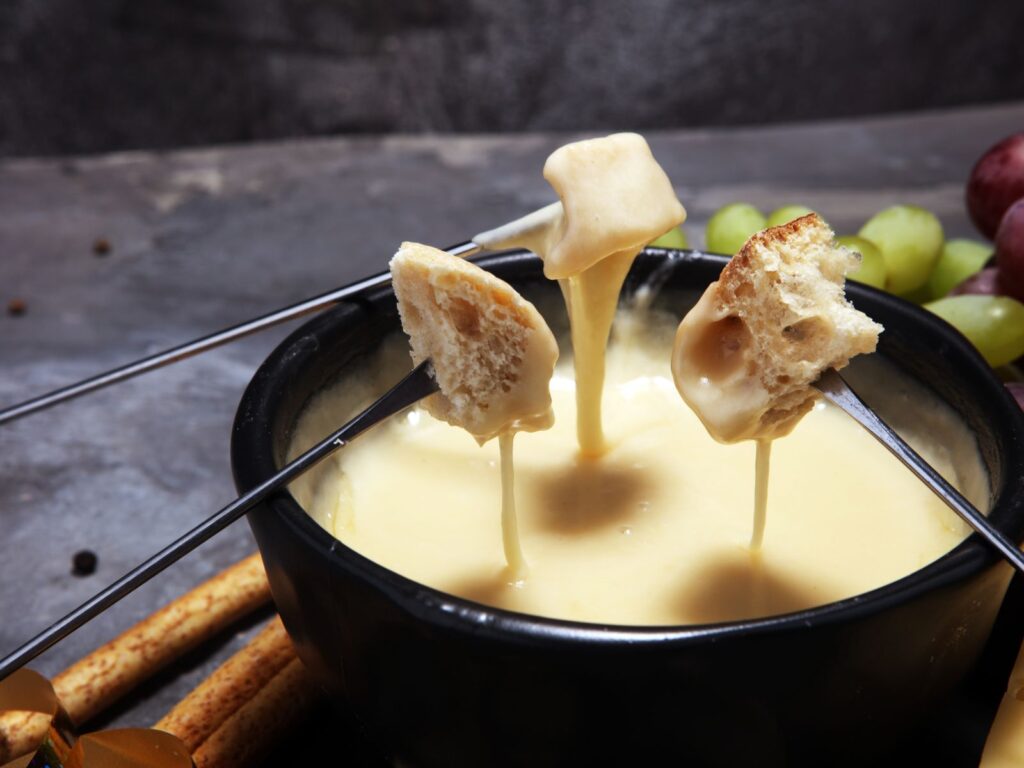
Without a doubt, this cheese is complex enough to be served as a table cheese. And, of course, you can (and should) eat Gruyère’s gorgeous natural rind.
Furthermore, you can pair this semi-hard mountain cheese with a glass of red wine like Pinot Noir or Syrah and something sweet.
Some of my favourite accompaniments include muscatels, quince paste, hazelnuts and plain crackers. Also, as with most pressed cheeses, you can pair Gruyère with charcuterie like prosciutto or salami.
Having said that, the most spectacular way to eat this cheese is to melt it! The Swiss make a type of cheese fondue called Moitié-Moitié using 50% Gruyère and 50% Vacherin Fribourgeois. In addition to fondue, Gruyère is a great addition to any Grilled Cheese Sandwich or Cheese Burger.
Nutritional facts
Gruyère cheese is a flavourful cheese with a rich nutritional profile. It is relatively low in lactose, making it a suitable option for individuals with lactose intolerance.
While it contains a moderate amount of fat and cholesterol, the overall balance of fats in Gruyère cheese makes it a valuable addition to a well-rounded diet.
Additionally, Gruyère cheese is a significant source of high-quality protein and dietary calcium. As with any food, moderation is key, and incorporating this Swiss cheese into a diverse and balanced eating pattern can provide both taste and nutrition.
You can read more about the nutritional profile of Gruyère cheese in our post here.
Alternatives to Gruyère
While Gruyère cheese is undeniably exquisite, there may be occasions when an alternative becomes necessary. Perhaps you’re hosting a cheese tasting event and want to showcase a variety of flavours, or maybe you’re simply looking to experiment with new tastes.
Whatever the reason, exploring alternatives can expand your cheese repertoire and open doors to exciting culinary experiences.
Some great substitutes for Gruyère are:
- Comté: Originating from the Franche-Comté region of France, Comté cheese exudes a unique complexity of flavours. Its nutty and caramel undertones, combined with a silky texture.
- Appenzeller: Taking centre stage in the Swiss cheese scene, Appenzeller cheese offers a bold and complex flavour profile.
- L’Etivaz: Crafted in the Swiss Alps during summer months, L’Etivaz is a firm and smooth cheese with nutty, fruity flavours, hints of caramel, and a delicate floral aroma.
You can read more about our top alternatives to Gruyère cheese in our comprehensive guide here.
Conclusion: Gruyère is a Swiss national treasure
Thank you for reading our post on Switzerland’s most treasured cheese, Gruyère. As you can see, this cheese’s history dates back to medieval times and its production is steeped in tradition. And those traditional methods produce a cheese that is unlike any other.
What’s your favourite age of Gruyère? Drop me a comment below.



